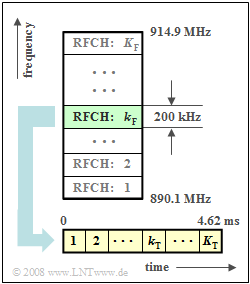Exercise 1.1: Multiplexing in the GSM System
The "Global System for Mobile Communication" $\rm (GSM)$ standard, which has been established in Europe since 1992, uses both frequency division and time division multiplexing to enable several users to communicate in one cell.
Some characteristics of the system are given below in a somewhat simplified form. A more detailed description can be found in the chapter General Description of GSM in the book "Examples of Communication Systems".
- The frequency band of the uplink (connection from the mobile to the base station) is between $\text{890 MHz}$ and $\text{915 MHz}$.
- Taking into account the guard bands $($each $\text{100 kHz)}$ at both ends, a total uplink bandwidth of $\text{24.8 MHz}$ is available.
- This band is used by $K_{\rm F}$ subchannels ("Radio Frequency Channels"), which are adjacent in frequency with a respective spacing of $\text{200 kHz}$. The numbering is done with the running variable $k_{\rm F}$, starting with $k_{\rm F} = 1$.
- The frequency range for the downlink (connection from the base station to the mobile) is $\text{45 MHz}$ above the uplink and is structured in exactly the same way as the uplink.
- Each of these FDMA subchannels is used simultaneously by $K_{\rm T}$ users via TDMA ("Time Division Multiple Access").
- A time slot of duration $T ≈ 577 \ \rm µ s$ is available to each user at intervals of $\text{4.62 ms}$.
- During this time, the (approximate) $156$ bits describing the speech signal must be transmitted, taking into account data reduction and channel coding.
Hints:
- This exercise belongs to the chapter Objectives of Modulation and Demodulation.
- Particular reference is made to the pages
Questions
Solution
- $$K_{\rm F}\hspace{0.15cm}\underline{ = 124}.$$
(2) The center frequency of the first channel is $\text{890.2 MHz}$. The "RFCH 100" channel is $\text{ 99 · 200 kHz = 19.8 MHz}$ higher:
- $$f_{\rm M}= 890.2 \ \rm MHz + 19.8 \ \rm MHz\hspace{0.15cm}\underline{ = 910 \ \rm MHz}.$$
(3) To apply the logic from subtask (2), we transfer the task into the uplink:
- The same channel with the identifier $k_{\rm F}$, which uses the frequency $\text{940 MHz}$ in the downlink, is located at $\text{895 MHz}$.
- Thus:
- $$k_{\rm F} = 1 + \frac {895 \,\,{\rm MHz } - 890.2 \,\,{\rm MHz } }{0.2 \,\,{\rm MHz }} \hspace{0.15cm}\underline {= 25}.$$
(4) In a TDMA frame of duration $\text{4.62}$ millisekconds, $K_{\rm T}\hspace{0.15cm}\underline{ = 8}$ time slots with a respective duration of $T = 577 \ \rm µ s$ can be accommodated.
- Note: For GSM, $K_{\rm T} = 8$ is actually used.
(5) Using the results of subtasks (1) und (4) we obtain:
- $$K = K_{\rm F} \cdot K_{\rm T} = 124 \cdot 8 \hspace{0.15cm}\underline {= 992}$$
(6) Over the course of timespan $T = 577 \ \rm µs$ ⇒ $156$ bits must be transmitted.
- Thus, each bit has the time $T_{\rm B} = 3.699 \ \rm µ s$ available.
- This results in the (gross) bit rate:
- $$R_{\rm gross} = \frac {1 }{T_{\rm B}}\hspace{0.15cm}\underline {\approx 270 \,\,{\rm kbit/s }}.$$
- This gross bit rate includes the training sequence for channel estimation, the redundancy for channel coding in addition to the data representing the speech signal.
- The net bit rate for the GSM system is only about $\text{13 kbit/s}$ for each of the eight users.
